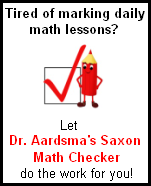|
"How To Help Your Child Succeed in Math" was originally published in 2001 to be sold along with the old CD version of Dr. Aardsma's Math Drill. Even though we now have the web-based Dr. Aardsma's Math Drill, the principles outlined in "How To Help Your Child Succeed in Math" are still applicable --- and not only to math, but to spelling as well.
How to Help Your Child Succeed in Math
by Dr. Gerald E. Aardsma
2001
Mrs. Aardsma and I have ten children (so far). We home school all of our
children up through high school, and then we send them to college.
We have sent our three oldest to college so far. Though they were not
all born with an aptitude for math, all three have scored very highly in the
math sections of their college entrance exams, and none has had any trouble
with math at college.
In this little booklet I mean simply to share how I have helped my children
succeed in math, in hopes that it may be of help to others seeking to do the
same. Though I hold an earned Ph.D. in physics and have a great deal
of formal math education in my background as a result, you don't need a
degree, or even any personal math aptitude to use my method successfully.
Basic Principles
My method entails two basic principles:
Principle 1.
Supply the student with a good math curriculum, from grade 1
through high school, and see that they work systematically through it.
Principle 2.
Build a strong foundation at the grade school level, and subsequent
years will pretty much look after themselves.
That's really all there is to it. All that remains is for me to explain how
I put these principles into practice.
Principle 1
Supply the student with a good math curriculum, from grade 1 through high
school, and see that they work systematically through it.
As I see it, my major role in helping my children succeed in math is
NOT to teach them math. Not only do I not have time to teach them
math --- that is, to prepare chalkboard lectures and student exercises --- there
is really no point in me taking the time to teach them math. There are
many fine textbooks (and, these days, computer courses) which have been
written expressly for the purpose of teaching children math. Much effort and
experience has gone into constructing these instructional materials. Someone
has gone to the work of figuring out what material should be included, in
what order the material should be presented, how much of the material to
present each lesson, and what student exercises would be most helpful to the
student. Why should I duplicate all of this effort?
Mrs. Aardsma teaches the children to read. As soon as they are able
to read I supply them with a good textbook (or, more recently, a computer
CD), and see that they begin to work their way through the material as
scheduled.
My role is not to teach my children math. My role is to see that my
children learn math. To fulfill my role I:
1. supply my children with a basic curriculum, and
2. see that they work systematically through it.
Supplying the Curriculum
The first of the two items just mentioned is fairly easy. Mrs. Aardsma gets
many home school catalogs mailed to her each year. She asks me which
curriculum I would like for math. I tell her; she orders it; I pay the bill.
We have personally used Rod and Staff Math and also Saxon Math.
We are presently using Alpha Omega Math (on CD-ROM). All of these are
excellent. [Note added 2011: We switched away from Alpha Omega and back to Saxon several years ago, feeling that Saxon was doing a better job of preparing our students for their college entrance exams and college courses. The big negative with Saxon for homeschool had always been the large amount of time the teacher had to take checking the students' work. This is especially true if students are required to get all answers right before proceeding, as is our policy. We solved this problem for our homeschool by developing Dr. Aardsma's Saxon Math Checker (www.DrAardsmasSaxonMathChecker.com), making this superior curriculum much more attractive in a homeschool setting.] Basic math has been around for a very long time. As a result little
controversy remains about what a math textbook should contain. "New
Math" is a publisher's gimmick, in my opinion, intended to get textbook
purchasers to spend money on new textbooks when the old ones they are
already using are still, in fact, just fine. Purchase a standard curriculum
from any reputable publisher and you can't go wrong.
Providing Discipline and Accountability
The second item --- seeing that the student works systematically through
his/her course of study --- is a little less straightforward and needs some explanation
and emphasis.
None of my children has ever begged to spend extra time doing math
each day. They have all had many other things they would rather do than
math: run and play outside, take a drive to the Dairy Queen, or read a good
adventure story, for example.
This has meant that I have had to make them learn math. I don't mean
to imply that this has been a daily struggle, for it most certainly hasn't.
But it has meant that I have had to set up some system of accountability to
make sure each child has completed his or her math lesson each day. This is
any home-educator's major task and responsibility, in my opinion.
Before the advent of computer math curricula, I marked my children's
hand-written math exercises each evening. I gave them back their exercises
with any wrong answers circled in red. (I knew which answers were wrong
because I had the teacher's books with the answer keys in them.) I insisted
they get 100% of the questions right before they were dismissed for the
evening. You can see that I was providing accountability and the discipline
needed for them to work systematically through the textbook, one lesson
per day.
Our home school computer has now freed me from the repetitive (and
boring) chore of marking. We now use a computer math curriculum. It
checks the children's work each day, so I no longer need to check their work.
It keeps track of their scores and their progress through the material. Mrs.
Aardsma keeps her eye on these records at the same time she checks the
computer records of their other subjects. Thus, happily, my workload of
marking is much reduced because of the computer. Notice, however, that
the principle of accountability is still the same. Mrs. Aardsma and I are
watching to see that the children complete their work each day.
My children find that, though I am not a harsh leader in any general
sense, I am really quite heartless about math accountability. I do not accept
excuses for incomplete work, period. The work will be completed each day,
as long as it is a regular home school day.
Several of my children have, at one point or another, shed tears as they
have told me that their math work was just too hard to complete. I have listened
sympathetically and then told them that they must tough on through
it and get it done anyway.
I will not let them off the hook. Success does not come by giving up. It
comes only by persevering. Recall: "Those who sow in tears shall reap with
joyful shouting" (Psalm 126:5, NASB,). My job is to see to it
that they keep systematically on, even when the going gets tough. I ignore
their tears and make them tough on through because I love my kids, and I
want to see them "reap with joyful shouting".
None of my children has ever come back afterward and said they wish I
had let them off the hook. Nobody enjoys being a quitter, really. Part of
my job is to love them enough to provide the additional willpower needed
to help them discover that they can conquer the seemingly impossible task.
Principle 2
Build a strong foundation at the grade school level, and subsequent years will
pretty much look after themselves.
The second principle of my method is to build a good foundation in the
early years. This is simply a recognition of the fact that a strong building
requires a strong foundation.
Building a strong foundation in math is not difficult, but it is a little
different than one might think at first. Math aptitude involves good abstract
reasoning and logical thinking abilities. But, curiously, a strong foundation
for math is not built on these abilities. Rather it is largely, necessarily, built
on memory work.
If you leaf through any set of grade school math textbooks you will
rapidly see that this is the case. The students spend most of their time in
the early grades memorizing math facts (typically in excess of 400 addition,
subtraction, multiplication, and division facts) and math procedures (e.g.,
how to add with carrying, and long division). This is all memory work, not
practice in abstract reasoning or logical thinking.
Now here is the second curious thing. Frequently a student who has
good abstract reasoning and logical thinking abilities (i.e., they have good
math aptitude) will not have good memory ability. This means that it is
quite possible for a child with good math aptitude to do poorly in math
in the early grades. Memory is just not their strength --- logic and abstract
reasoning is where they shine. They struggle with all the memory work in
those early grades. And, unfortunately, if the teacher does not understand
what is going on, it is possible for these students, despite their fine math
aptitude, to wind up with a poor foundation and a bad attitude toward math
in general by the time they reach junior high school.
The only way I know to prevent this is to supplement the textbook
curriculum with extra memory drills of the basic math facts. I'm
talking about basic flash-card memory drills here. In my opinion, this is the
key to building a truly solid foundation for math at the grade school level.
There really is no alternative to these flash-card drills. All of this memory
work is absolutely vital to math success. The junior high student who cannot
tell you in an instant what 8 times 6 equals doesn't really have a hope of
succeeding in higher level mathematics, no matter how good their abstract
reasoning and logical thinking abilities may be. Higher level math builds
upon the basic addition, subtraction, multiplication, and division facts. The
student who has to figure out what 8 times 6 is each time they encounter
it will find, at the higher math level, that they are having to figure it out
about 48 times per day. Worse still, there will be in excess of 400 other
math facts, each of which they will face and need to figure out about 48
times per day as well. It will obviously be difficult for a student to make
any progress in higher math courses while laboring under such a burden. For
success in higher mathematics, one really does require a solid, rote-knowledge
foundation of the basic math facts.
Drilling the Basic Math Facts
To ensure such a foundation in my children, I systematically drill 600 math
facts with them, working through a select subset of these each day. I do this
as a supplement to the regular textbook or computer CD curriculum from
grade 1 through grade 7.
I started doing this with my oldest child, Jennifer, roughly two decades
ago, using a set of homemade flash cards. Mrs. Aardsma has shared my
experience in her Christian women's publication, The Mother's Companion ("The One Room Schoolhouse", Volume 6, Number 3, pages 8--11.)
Gerald [Dr. Aardsma] built us a small computer back in the
early eighties, before they were commercially available, and one
of the first things he did with it was to program it with a math
drill for Jennifer. Jennifer is our oldest, now married and with a
baby of her own. Back at that time she was in second or third
grade.
Gerald had been using a very thick set of homemade flash
cards to drill the basic addition, subtraction, multiplication, and
division facts with Jennifer. He was working on a Ph.D. in
physics at the time, and he knew how important it is for children
to have the basic math facts memorized as a foundation for all
future work in mathematics.
Jennifer, unfortunately, did not have the same mature perspective
on this daily math drill her Daddy had. She was a sharp
little student and had no problem learning the facts and reciting
them, but she quickly became bored with the whole routine.
She found it much more fun to experiment with her Daddy's
patience --- impishly delaying as long as she could manage, for a
whole myriad of postulated reasons, and giving wrong answers
just for the fun of it.
So Gerald --- who has yet to be defeated by the wiles of a
child --- built a simple computer and put the drill on the computer.
The computer didn't mind sitting and waiting all day for
the answer, if that was Jennifer's choice. But it kept track of her
best times on each math fact, and heartlessly beeped at her and
subtracted points from her final score if she didn't answer fast
enough. It also mercilessly took off points if she got an answer
wrong. And it kept track of which facts she was having trouble
with, and drilled those more often. Gerald's job was reduced
to merely monitoring Jennifer's progress by checking the score
which the computer printed out after each drill."
You can see that I quickly learned that I didn't really want to spend time
each day drilling math facts by hand. The fun of the experience had worn
off after about the first week. If drilling by hand had been my only option I
would have continued to do so regardless of the strain and boredom, because
I really did want to see Jennifer succeed in math. But, fortunately, just at
the time I needed it the home computer option opened to me.
Computer Math Drill
Computers are really perfect for this task, as the quote above explains. But
home computers were just beginning to become available back at that time.
They cost way more than a below-the-poverty-line Ph.D. student with four
children (at that time) could afford. So I built my own computer, working
with the basic chip sets then available.
But even that didn't solve my problem. I needed not only a computer,
but also software --- a basic operating system, and a math drill program. Neither
were commercially available at the time. So I wrote my own operating
system in conjunction with my own assembler, and then I used my assembler
to write my own math drill program --- all as a fun, after-hours diversion from
my Ph.D. course of study.
I don't have any statistics on this, but I think there is a very good chance
my math drill --- Dr. Aardsma's Math Drill, as it is now called --- was the very
first computerized home educational math drill in the world.
Be that as it may, it worked like a charm. To be perfectly honest, it
did a much better job of drilling the basic math facts than I had been able
to do with the flash cards. For one thing, it never made mistakes. For
another, it 'remembered' Jennifer's performance from lesson to lesson. This
allowed the computer to drill facts she was having trouble with more often.
And it allowed the computer to 'know' when Jennifer could answer more
quickly. The result was a fast-paced, customized drill which put Jennifer
in competition with her previous best performance to see what new level
of performance she could come up to each day. Jennifer was given a very
thorough drill of basic math facts each day, and I was released to pursue
other goals and fulfill other duties.
It was a drill, of course, not a game. I don't personally care much
for 'educational' computer games. I did a lot of 'textbook' learning, from
kindergarten up through Ph.D. --- about a quarter of a century worth, in
fact --- and none of it was much of a game (which is not to say it was all
drudgery, by any means!). The truth is --- like most worthwhile things in
life --- learning is work. It is generally frustrating work, in my experience. I
don't want my children to get the false impression that they can succeed by
playing games. I also don't want them to develop the habit of only applying
themselves to something if they think it's fun. Finally, I want them to be
able to focus on the task when they sit down to do their math drill, without
the nuisance of game elements slowing them down and getting in their way.
You can see that I expect my children to grow up with an understanding
that the road to success in life is not strewn with gumdrops, and that
true satisfaction results from overcoming difficulty and adversity, not from
avoiding it.
The Drill Today
We have kept that basic math drill running in our home school ever since ---
over fifteen years! It has changed computers several times, and today it
runs under DOS rather than my own proprietary operating system, but it
is still the same basic program doing the same job. [Note added 2011: For the past several years Dr. Aardsma's Math Drill (and Dr. Aardsma's Spelling Drill) have been web based, at www.DrAardsmasDrills.com.] Jennifer is grown and
married with a baby of her own. But Jennifer's younger brothers and sisters
still do their daily math drill, just like Jennifer did. Why change a winning
formula?!
The Daily Routine
An encouraging question to ask when faced with a big task is, "How was the
Empire State Building built?" The correct answer is, "One brick at a time."
(I am told that the Empire State Building, though faced with limestone,
contains roughly ten million bricks.)
Big tasks can appear overwhelming or impossible at the outset. But
when we focus on the small subtask immediately at hand --- laying that next
brick --- we can accomplish very big things.
Building a child's education can seem like a pretty overwhelming task
at the outset. But in real life it only happens one day at a time. Focus
on getting the daily routine running smoothly, and you'll be amazed and
pleased at the results in twelve years.
The daily math routine in our home school is very simple. The children
first do their math lessons (not drills) on the computer. The computer
corrects their lessons and grades their work for the day. Then they do their
supplementary math drills (i.e., Dr. Aardsma's Math Drill) on the computer.
I require each child to get a score of at least 80% on his or her drill. If they
get less than 80% they must do another drill until they finally have achieved
80% or better. At that point they instruct the computer to print a daily
Math Drill 'score card'. This prints their name, the date, and their score for
the day.
The next morning, at our family gathering for Bible reading and prayer,
they hand their score cards in to me. I check these for proper name, date,
and an acceptable score. I generally announce the highest score for the day.
Appropriate disciplinary action is taken as needed at this time as well.
For example, if a child has no Math Drill score card to hand in (they forgot
to do it, or it got misplaced) I require them to hand in two extra drill 'report
cards' (in addition to their regular drill) the next day. But in actual fact,
discipline problems are rare in our home. The routine flows smoothly from
day to day and the skyscraper slowly but surely goes up.
Conclusion
Here, then, are the two principles I have used to help my children succeed
in math:
Principle 1
Supply the student with a good math curriculum, from grade 1 through high
school, and see that they work systematically through it.
Principle 2
Build a strong foundation at the grade school level, and subsequent years
will pretty much look after themselves.
I recommend the application of these two principles to any parent concerned
to see their child succeed in math.
Appendix: The Basic Idea Behind Math Drill
Math Drill is conceptually simple. It is really just an old-fashioned flashcard
drill, designed for use in grades 1 through 7. The big difference is that
a computer takes the place of the teacher presenting the drill.
Math Drill has 600 flash cards in its deck. These contain all of the
basic addition, subtraction, multiplication, and division facts, plus questions
on identification (e.g., what is the 6 called in the equation "6 + 3 = 9"?
[answer: addend]), place value, Roman numerals, units, and time and coin
conversions.
Math Drill keeps track of a student's speed and accuracy with each individual
flash-card question, and evaluates present performance relative to
that student's past performance with each individual flash card. It more
frequently reviews questions a student is having trouble with, to strengthen
weak areas.
Think of Math Drill as a stern and demanding (but never unfair or
unkind) school teacher, dedicated to helping a student perform at their best
possible level in math.

|





